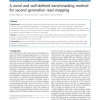242 search results - page 21 / 49 » Finding effective compilation sequences |
BMCBI
2006
13 years 7 months ago
2006
Background: Genome sequences vary strongly in their repetitiveness and the causes for this are still debated. Here we propose a novel measure of genome repetitiveness, the index o...
BMCBI
2011
13 years 2 months ago
2011
Background: In many environmental genomics applications a homologous region of DNA from a diverse sample is first amplified by PCR and then sequenced. The next generation sequenci...
EDM
2009
13 years 5 months ago
2009
Researchers who make tutoring systems would like to know which sequences of educational content lead to the most effective learning by their students. The majority of data collecte...
BMCBI
2008
13 years 7 months ago
2008
Background: Accurate identification of splice sites in DNA sequences plays a key role in the prediction of gene structure in eukaryotes. Already many computational methods have be...
BMCBI
2011
12 years 11 months ago
2011
Background: Second generation sequencing technologies yield DNA sequence data at ultra high-throughput. Common to most biological applications is a mapping of the reads to an almo...

